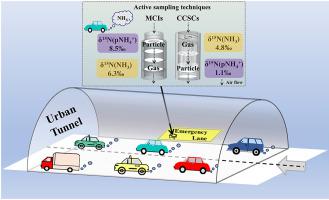Atmospheric Environment ( IF 4.2 ) Pub Date : 2021-04-23 , DOI: 10.1016/j.atmosenv.2021.118430 Linlin Song , Wendell W. Walters , Yuepeng Pan , Zhengjie Li , Mengna Gu , Yihang Duan , Xuemei Lü , Yunting Fang

|
Vehicular exhaust has been identified as an important ammonia (NH3) emission source in urban areas using the stable isotope tracer technique (δ15N); however, its δ15N signature remains poorly constrained due to difficulties in concentrating and speciating NHx (NH3 + particulate NH4+). In this study, we deployed two active sampling techniques, MCIs (Multi-nozzle Cascade Impactor sampler; “particle-gas” order) and CCSCs (ChemComb Speciation Cartridge sampler; “gas-particle” order), to collect vehicular exhaust NHx in a long urban tunnel in Shenyang, China, and quantified the 15N from the collected NH3 and NH4+. While no significant difference in tunnel NH3 concentrations between the two samplers was observed (n = 21), the δ15N-NH3 was slightly higher using the MCIs (6.3 ± 1.6‰) compared to the CCSCs (4.8 ± 2.3‰) during the tunnel operation period. This minor absolute difference of 1.5 ± 2.8‰ may derive from denuder-saturation used within the CCSCs that lead to NHx speciation ambiguity, which also caused significant δ15N-pNH4+ differences between the two sampling approaches. Our results suggest that both active samplers can well characterize the δ15N-NHx in the ambient environment, but the “particle - gas” sampling approach performs better in elevated NH3 concentration environments. We recommend that the δ15N value of 6.3‰ is used as the isotope end member for vehicle NH3 when performing NH3 source apportionment.











































 京公网安备 11010802027423号
京公网安备 11010802027423号